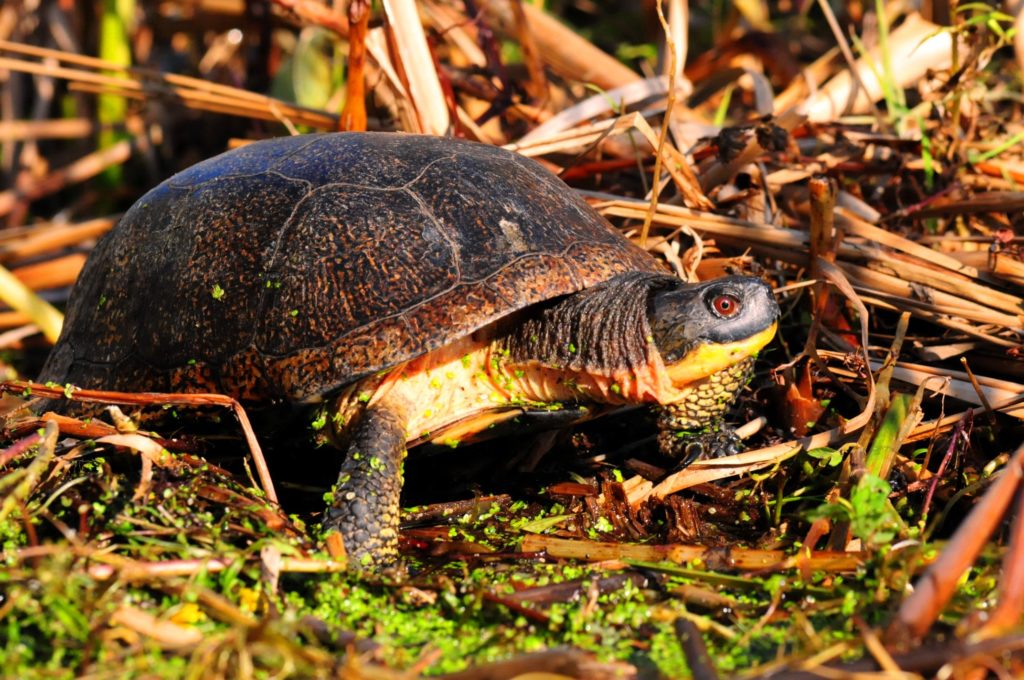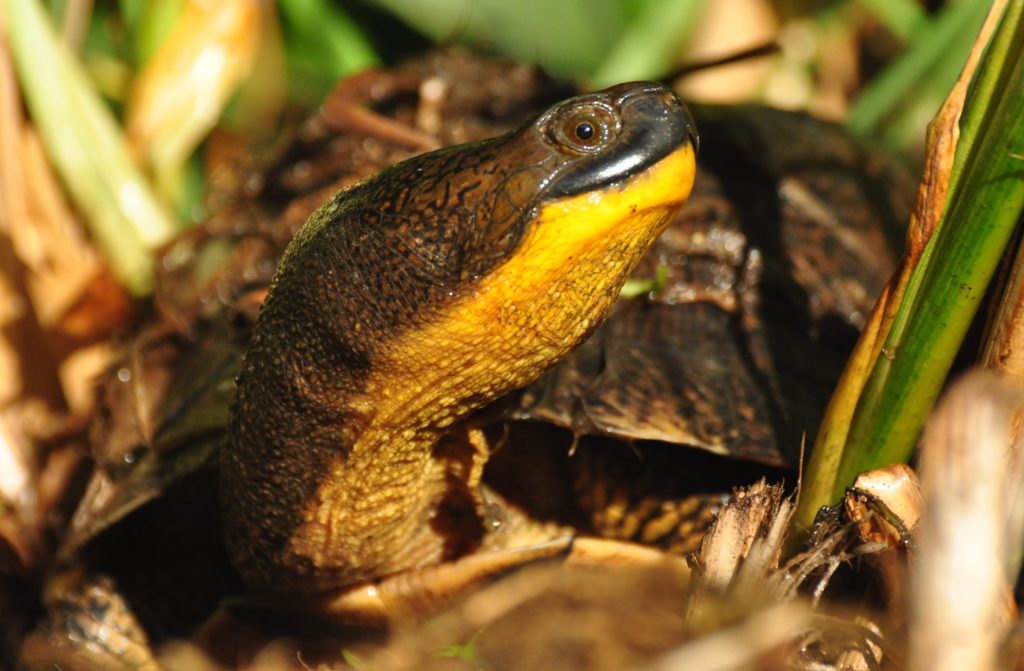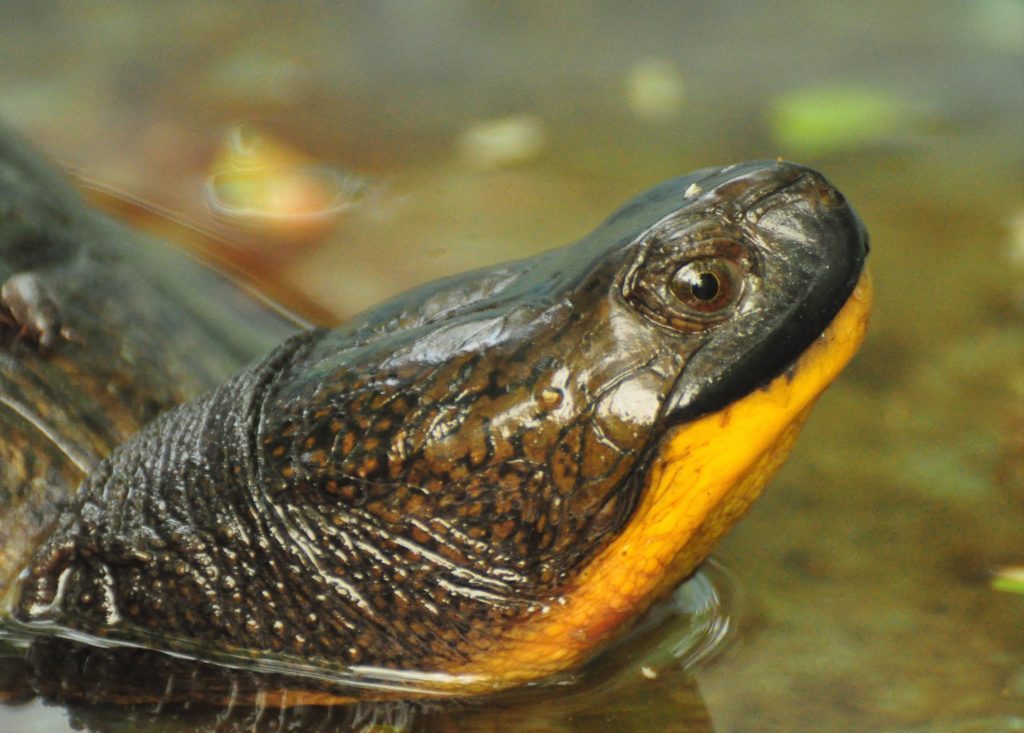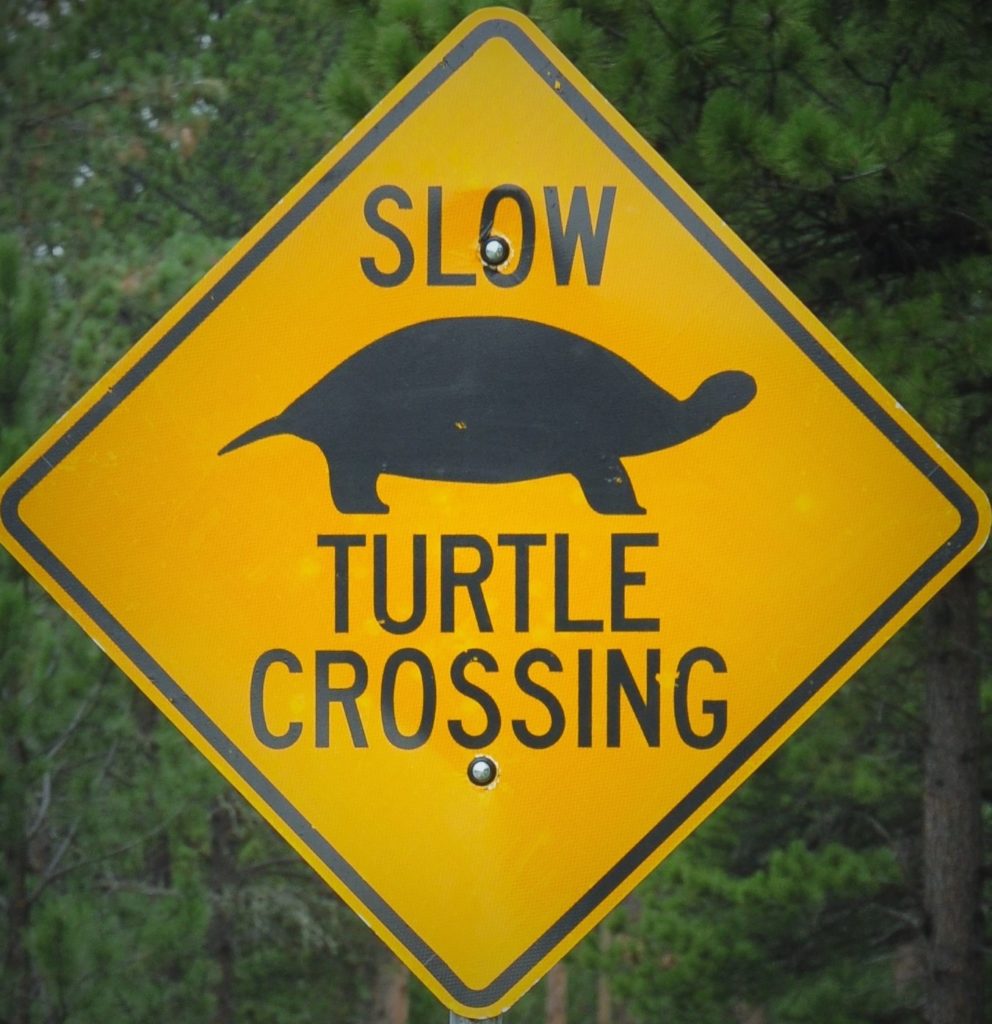Photography courtesy of Lowell Washburn, all rights reserved.
With its distinctive high-domed helmet-shaped upper shell, bright yellow throat, and endearing smile, it would be hard to mistake the Blanding’s turtle for anything else. Sadly, it is a species that most Iowans will never have an opportunity to view. There are exceptions, of course. Take for example, the adult Blanding’s recently seen making its way across Cerro Gordo county’s S14 blacktop that runs adjacent to the western edge of Wild Goose Marsh, a 156-acre DNR managed public wetland located four miles north of Ventura.
Road crossings are extremely hazardous for Iowa turtles. Many are killed – especially during late spring and early summer when large numbers of adults leave native wetlands in search of drier soils where they can dig nests and lay their eggs. In the case of the Blanding’s, the ongoing danger was graphically illustrated when the tires of an oncoming vehicle missed the slow-moving reptile by mere inches. It was a near miss that could have easily ended the life of one of Iowa’s most interesting, but rarest, forms of wetland wildlife.

Fortunately for this Blanding’s, the next vehicle was driven by Iowa Conservation Officer, Matt Washburn who pulled aside to ensure the turtle did not become the species’ latest grim statistic. A magnificent specimen, the Blanding’s was the largest Washburn had ever encountered and well worth taking time to weigh and measure before letting it continue its journey. With a carapace (top shell) measurement exceeding ten inches and weight of nearly 4 ½ pounds, the turtle was indeed a genuine ‘Booner’ and was as large as Blanding’s turtles get.
Although historically abundant, Blanding’s turtles have currently fallen on hard times. The species has become so rare, in fact, that most Iowans – even those who spend considerable time prowling the out-of-doors — will never see so much as a single Blanding’s in their lifetimes.
Several factors have contributed to the Blanding’s decline. Although more than a century of wetland drainage has negatively affected all of Iowa’s thirteen turtle species, some of our more familiar varieties – such as painted and snapping turtles — have managed to maintain relative abundance. By contrast, Blanding’s turtles have been far less successful at adapting to ever changing, modern-day landscapes.
The species’ low reproductive rate has compounded the dilemma. It takes a Blanding’s female twelve to fifteen years — sometimes longer — to produce her first clutch of eggs. After that, a female may only produce eggs every other year. By comparison, a painted turtle may lay eggs during its fifth summer and will often produce a clutch every year thereafter.
When compared with other members if its family, Blanding’s turtles are exceedingly prone to wander, frequently launching lengthy overland journeys to find nesting sites or explore new wetlands. While many turtles will dig nests and lay eggs within fifty yards or less of their wetland homes, female Blanding’s have been known to travel up to a mile or more in search of a perfect site.

All Iowa turtles suffer significant nest losses during the annual breeding season — mainly due to skunks and raccoons that dig up nests and consume the eggs. For Blanding’s turtles, however, the measure of nest destruction could best be described as catastrophic, with egg losses routinely exceeding eighty and even 90 percent, according to the findings of a wildlife study conducted in southern Minnesota. Although Blanding’s and other turtles have historically endured predator nest loss, current populations of raccoons and striped skunks far exceeds the numbers found on pre-settlement landscapes. Egg losses have never been higher. For the handful of Blanding’s nests that are successful, losses continue as predators of all kinds exact a toll on soft shelled, infant hatchlings.
Historically, slow growing Blanding’s turtles were able to offset low recruitment by being exceptionally long lived. In captivity, individuals have been known to live for more than 80 years and, in natural wetland settings, have theoretical productive lifespans of a century or more. It is unfortunate that the Blanding’s extreme longevity may also give a false impression that populations are stable. But as DNR Wildlife Diversity Biologist, Bruce Ehresman once stated, “We’re seeing the same turtles our grandparents watched.”
Given its size and weight, the turtle Matt Washburn encountered had likely been roaming the North Iowa marshlands for six or seven decades, and possibly more – which is longer than most of the people reading this column have been on the scene.

Sadly, I am not unique in the fact that every Blanding’s turtle I’ve seen in my lifetime has been an adult, and I’m seeing far less of those than I used to. The last Blanding’s I saw in the wild was eleven years ago during what became a memorably bizarre encounter. I was bow hunting for spring turkeys on the Don Nissen farm, located along the Winnebago river southwest of Fertile. Arriving well before daybreak, I had popped up my archery blind atop some tall grasses that were now laid flat by the previous winter’s snowfall. After settling in, I soon became aware that I was not alone in the pitch dark. Inside my blind, something was stirring beneath the lodged grasses. My first thought was skunk. My second thought was raccoon. Space was tight and neither option – being sprayed or being bitten – seemed all that appealing. After a couple more minutes of listening to the rustling, I cautiously reached out to see what I could determine. To my relief, it was neither a skunk or raccoon. What my hand detected instead was the hard shell of a turtle. I didn’t have to wait for daylight to determine the species, the smooth helmet-shaped dome of the upper shell told me all I needed to know – I had inadvertently captured a large Blanding’s turtle. I don’t remember whether or not I bagged a gobbler that spring morning – probably not. But what I will remember – probably forever — is the implausible probability of successfully capturing a Blanding’s turtle, simply by means of accidentally placing an archery popup blind directly over the top of what may have been the species’ only representative for miles around.
In Iowa, the Blanding’s turtle is officially listed as a “Threatened Species of greatest conservation need.” It is illegal to kill or capture one. Vehicle strikes remain the number one cause of adult mortality. It would be hard to overstate the value of an adult Blanding’s turtle when, in extreme cases, the loss of a single female can doom the entire population of isolated marshlands.
In neighboring Illinois, Blanding’s turtles are officially listed as an Endangered Species. For wildlife ecologist, Gary Glowacki, the ongoing decline was entirely unacceptable. Beginning in 2010, Glowacki began a conservation program called “Head Starting”, a project where Blanding’s turtle eggs are hatched in captivity and the babies released to the wild. But instead of stocking marshland habitats with infant hatchlings, Head Start babies are raised to larger, subadult sizes before being liberated. Last month, Glowacki was able to release 53 juvenile Blanding’s into suitable Illinois habitats. A total of 934 advanced young have been reared and released since 2010.
A sample of the turtles are being tracked; the results are encouraging. With baby turtles receiving protection during the most vulnerable phase of their life cycle, survival of released adolescents has increased dramatically. Some populations appear to be stabilizing; a handful are showing a modest increase as enhanced survival of juveniles bolsters overall numbers. As more and more of the released turtles mature, the project’s long-term success will hinge on the species’ ability to increase natural production. Time will tell.

Back here in Iowa, the Blanding’s turtle’s future remains largely uncertain. Hopefully, the ongoing restoration and enhancement of the state’s prairie lake and marshland ecosystems will aid in stalling further declines. For now, we can all cling to the hope that current trends will be reversed before the same turtles our grandparents watched disappear completely.

 Tom Cope
Tom Cope Sue Wilkinson
Sue Wilkinson Susan Judkins Josten
Susan Judkins Josten Rudi Roeslein
Rudi Roeslein Elyssa McFarland
Elyssa McFarland Mark Langgin
Mark Langgin Adam Janke
Adam Janke Joe Henry
Joe Henry Kristin Ashenbrenner
Kristin Ashenbrenner Joe Wilkinson
Joe Wilkinson Dr. Tammy Mildenstein
Dr. Tammy Mildenstein Sean McMahon
Sean McMahon